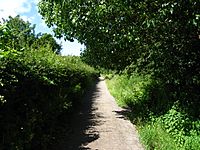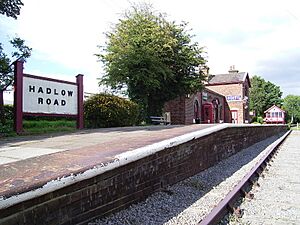Wirral Country Park facts for kids
Quick facts for kids Wirral Country Park |
|
|---|---|

The site of Kirby Park railway station, now given over to the Wirral Way.
|
|
| Lua error in Module:Location_map at line 420: attempt to index field 'wikibase' (a nil value). | |
| Type | Public park |
| Location | Station Road Thurstaston Merseyside CH61 0HN |
| Created | 1973 |
| Operated by | Metropolitan Borough of Wirral, Cheshire West & Chester |
| Open | All year |
| Status | Open |
The Wirral Country Park is a special outdoor area located on the Wirral Peninsula in England. It was the very first country park in Britain, opening way back in 1973! This park stretches across parts of Merseyside and Cheshire.
The park follows a path called the Wirral Way. This path used to be a railway line that ran from West Kirby to Hooton. The old railway line, which closed in 1962, runs along the River Dee estuary for about 7 miles (11 km) between West Kirby and Parkgate. After that, it goes inland across the Wirral Peninsula to Hooton.
You can find two visitor centers along the Wirral Way. One is near the old Thurstaston railway station at Thurstaston. The other is at the preserved Hadlow Road railway station in Willaston.
Park History
Work on the Wirral Country Park started in 1969. It officially opened in 1973, thanks to a successful effort by Captain Lawrence Beswick. His campaign helped get the money needed from the Countryside Commission to create the park.
Building the park meant a lot of work! Workers had to remove 30 miles (48 km) of railway tracks and wooden sleepers. They also dug new drainage channels and leveled thousands of tons of gravel. Some old brick bridges were also taken down. A few things from the original railway line are still there today. You can see the old station platform at Thurstaston and the preserved 1950s-era railway station at Hadlow Road in Willaston. You might also spot some old railway signs that show how steep the track used to be.
Amazing Wildlife
Wirral Country Park is home to many different animals and birds. You might spot badgers and foxes living in the park. There are also ten different types of butterflies that have been seen here!
The estuary, which is where the river meets the sea, is full of small creatures like ragworms, lugworms, and cockles. These creatures are food for many birds that visit the area. Look out for birds like common redshanks, common shelducks, northern lapwings, skylarks, meadow pipits, and terns.
If you visit during very high tides in spring, you might even see some impressive birds of prey. These include peregrines, hen harriers, and short-eared owls, which hunt during the day.
Fun Activities and Walks
Wirral Country Park is a very popular place for people who love to walk. There are many paths to explore. Here are three popular walks:
- One walk goes along the shoreline for a couple of miles from Thurstaston Beach to Heswall Beach. This path is also a favorite for horse riders.
- The Wirral Way is a longer walk, about 13 miles (21 km) long. It starts in West Kirby and goes all the way to Hooton. The country park itself is located along the middle part of this route.
- Another walk is a 3.5-mile (5.6 km) circle route around Heswall Dales and fields. It goes through a small valley known as 'The Dungeon'.
A well-known event in Merseyside is the Wirral Coastal Walk. Part of this walk goes through Wirral Country Park. It's an annual event organized by the Rotary Club. In 2008, over 5,000 people took part! The walk follows the Wirral coastline from Seacombe Ferry on the River Mersey to Thurstaston Country Park on the River Dee. This is a distance of about 15 miles (24 km). This yearly event is a great way for local charities to raise money for their causes.
Besides walking, Wirral Country Park is also popular for other fun activities. You can enjoy cycling, horse riding, kite flying, quad biking, and paragliding. The 12.2-mile (19.6 km) Wirral Way is especially popular with cyclists, especially on weekends. Part of the Wirral Endurance Ride, a horse-riding competition, also takes place along the Wirral Way.
Gallery






